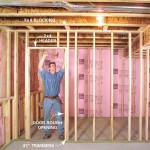Does a Ranch Style House Have a Basement?
The ranch style house, known for its single-story design and sprawling layout, is a popular architectural style in the United States. Often associated with suburban communities, these homes prioritize ease of living and practicality. While most ranch houses are designed without a basement, certain factors can influence their presence or absence. Understanding the reasons behind the typical absence of basements in ranch homes and the exceptions to this rule provides valuable insight into the characteristics and variations of this popular architectural style.
The Prevalence of Slab Foundation in Ranch Style Houses
A primary reason why many ranch houses lack basements is their construction on slab foundations. Slab foundations are poured directly onto the ground, creating a solid base for the structure. This method is favored for its efficiency and cost-effectiveness, particularly in areas with stable ground conditions and moderate climates. Unlike crawl spaces or basements, slab foundations require minimal excavation, reducing construction time and expenses.
The use of slab foundations in ranch houses aligns with their emphasis on functionality and affordability. The single-story design eliminates the need for stairs, making them accessible and comfortable for individuals of all ages and abilities. Additionally, the absence of a basement simplifies maintenance and reduces the potential for moisture problems, which can be prevalent in basements, especially in humid regions.
Factors That Can Influence the Presence of a Basement in a Ranch House
While slab foundations are the norm for ranch houses, certain factors can influence the inclusion of a basement. These factors include:
- Climate and Soil Conditions: In regions with harsh winters or prone to flooding, a basement can provide a safe and secure space for storage, utilities, and even living areas. In areas with unstable soil, a basement can offer additional support and stability to the house.
- Local Building Codes: Some localities mandate the inclusion of basements in residential structures, particularly in flood-prone areas or zones with unique soil conditions. These codes prioritize safety and minimize the risks associated with natural disasters.
- Personal Preference: While not a common feature, some homeowners choose to have basements included in their ranch houses to accommodate specific needs, such as additional living space, home offices, or recreational areas. These choices are often driven by individual preferences and lifestyle demands.
The Advantages and Disadvantages of a Basement in a Ranch House
The presence or absence of a basement in a ranch house comes with its own set of advantages and disadvantages. Understanding these considerations can help homeowners make informed decisions regarding the suitability of a basement for their needs and preferences.
Advantages of a Basement in a Ranch House
- Additional Living Space: A basement can provide valuable additional living space, offering a separate area for entertainment, recreation, or even a home office.
- Storage Space: Basements offer ample storage space for belongings, seasonal items, and tools, helping to declutter the main living areas of the house.
- Protection from Storms: In areas with severe weather, a basement can serve as a safe refuge during storms and natural disasters, providing protection from floodwaters, strong winds, and debris.
- Utility Room: Basements can provide a dedicated space for essential utilities, such as water heaters, furnaces, electrical panels, and laundry equipment, minimizing noise and clutter in the rest of the house.
Disadvantages of a Basement in a Ranch House
- Increased Construction Costs: Adding a basement to a ranch house increases construction costs significantly, primarily due to excavation, foundation work, and additional materials.
- Moisture and Mold Issues: Basements are susceptible to moisture buildup and mold growth, particularly in humid climates or areas with poor drainage. Regular maintenance and humidity control are essential.
- Potential for Pests: Basements can attract pests, such as insects, rodents, and spiders, requiring careful pest control measures to maintain a healthy and comfortable living environment.
Ultimately, the decision to include a basement in a ranch house depends on individual needs, preferences, and local conditions. While ranch houses are generally known for their single-story design and slab foundations, there are exceptions to this rule. Homeowners should carefully weigh the advantages and disadvantages of a basement and consult with a qualified builder or architect to determine the most suitable design for their specific requirements.

Do Ranch Style Homes Have Attics Or Basements

Ranch Basement Photos Ideas Houzz

What Is A Ranch Style House The Most Common Characteristics K Hovnanian Homes

Ranch Style With 4 Bed Bath 3 Car Garage House Plans Exterior Remodel Home Styles

Craftsman Style Ranch House Plan With Finished Walkout Basement

What Is A Ranch Style House The Most Common Characteristics K Hovnanian Homes

Walkout Basement Ranch Style House Plan 8757

Ranch Home On A Basement You Want It We Got Willows At Chastain Active Adult Community Marietta Kerley Family Homes

3 Bedroom Ranch Has Partially Finished Basement

Great Ranch W Optional Finished Basement The House Designers








